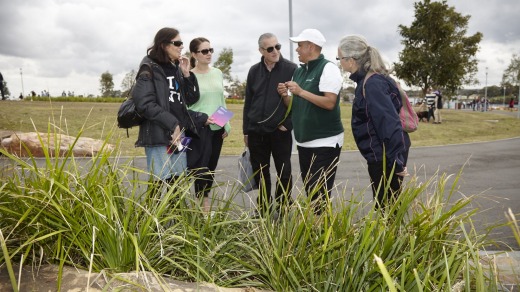At Marranawi Cove, Mary Mumbulla directs attention to the water. "Look, they're starting to come back."
She's pointing towards the cockles and oysters that were once a familiar sight here. For more than 100 years, almost no one has been allowed in to take a look. Those who worked here probably wouldn't have fancied their chances eating anything that was found, given the pollution from the wharves and container shipping port grime.
Small things like the odd oyster don't tend to generate the headlines when it comes to the Barangaroo project. It's all about the casino, the office towers and the opening up of long-closed harbour foreshore, but it is not all about the future, and Mary is attempting to explain how things used to be way before the area was concreted over for the port.

"This is the country of the Gadigal people. We acknowledge past and present ancestors," she says as we enter the 5.7-hectare reserve that forms the top part of Barangaroo. It is nothing if not striking, with 10,000 sandstone blocks having been quarried out from underneath, and placed very deliberately to create rock pools and general decoration. Each has been carved with its position in mind, and it acts as an artist's impression of what the land was like before Europeans arrived.
That's the period Mary attempts to evoke as she leads people around. She stops at a Carpobrotus glaucescens, better known as pigface, one of 75,000 native plants that have been seeded onto the headland. "It usually has a beautiful pink flower," she says. "When it's ripe, it's sweet but salty. You can also use it to ease blisters on your feet."
For the Indigenous people living around the harbour, the flower traditionally has a more important role. "When it's big, you know the fish are big and ready to catch."
There's a similar story for the dianella – its life cycle can be used like a calendar. "When you see that berry nice and ripe, it's when the flathead is ready to catch in the ocean," Mary says.
"It's also known as a woman's plant. During that time of the month, eating plenty of berries will fix up the cramps."
Other plants have other uses. A damper-style bread can be made from lomandra, which was also used for weaving fishing bags. The presence of water in the roots was usually a good sign that reptiles and small marsupials would be nearby too.
"As for the casuarina," Mary says, "Aboriginal women would tell children who were lost to sit under it. Reptiles and snakes won't go under the mat created by the fallen needles."
Mary is one of 20 Indigenous guides who have been trained as part of the Barangaroo scheme in conjunction with Eora College in Redfern. Five have been taken on to work at Barangaroo, while the other 15 have found work elsewhere.
The Aboriginal Cultural Tours will have a slightly different emphasis, depending on the guide's knowledge and skill set. "Jess is an artist," Mary says. "Bob is a very spiritual man who's very strong on his bush tucker. Me? I guess I'm a bit of an all-rounder."
She does have a particular interest in the woman the reserve was named after, though. "Barangaroo was a Cammeraygal woman, who was married to Bennelong."
Until now, Bennelong has been by far the better known of the pair. Bennelong Point is where the Sydney Opera House stands, and choosing Barangaroo as the name for the area on the other side of the city centre adds a pleasing symmetry.
Bennelong was kidnapped under the orders of Governor Arthur Phillip, who wanted to understand more about Australia's Indigenous people. Bennelong eventually became the favoured interlocutor, travelled to Britain in 1792, and became more westernised as time passed.
Barangaroo was much more wary, partly because the two children she had before 1788 died from disease, probably smallpox, introduced by the new arrivals. "She didn't want to drink alcohol and wear Western clothes," Mary says. "She also felt threatened by the big fishing nets of the colonisers."
This is indicative of how society was set up. The women were the hunters, who went out in canoes to catch fish, singing songs to keep the rhythm as they paddled. The men merely spearfished around the harbour's edge.
It also shows a difference in approach. The Europeans gathered whatever they could find, but the Indigenous clans only took small numbers. It was good sustainability practice long before its time.
The tour is full of little interesting titbits such as this, without being groundbreaking or overloaded with detail, but it doesn't need to be – the point is about accessibility. Prime land on the harbour that has been shut away for a century is being opened up to all, and huge numbers of visitors, both local and international, are expected to come. The Indigenous tours are a gentle way of opening eyes to a different perspective of the land and its heritage.
www.Barangaroo.com
The Barangaroo Indigenous tours cost $36.50, and can be booked via Eventbrite (www.bit.ly/barangaroo-tours). More details can be found at www.barangaroo.sydney.